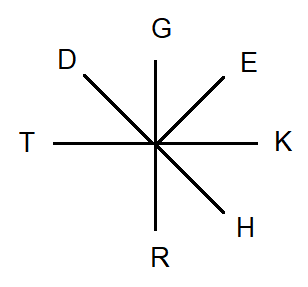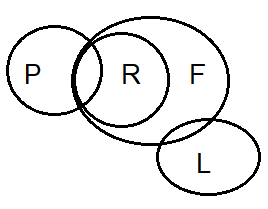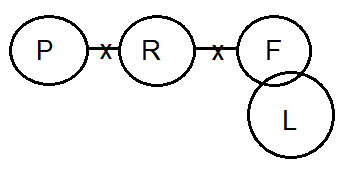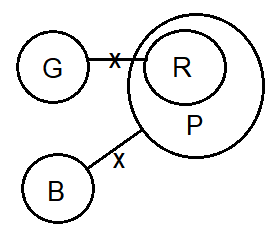
Dear Readers,
Mahendras has started special quizzes for IBPS & SBI Exam so that you can practice more and more to crack the examination. This IBPS & SBI Exam special quiz series will mold your preparations in the right direction and the regular practice of these quizzes will be really very helpful in scoring good marks in the Examination. Here we are providing you the important question of reasoning ability for the IBPS & SBI Exam.
Q.1-5. Study the following information carefully and answer the question given below.
Seven people are sitting around the circular table and all of them are facing towards outside the centre. D sits fourth to the left of H who is to the immediate right of K. There are three people sitting between R and G. G sits second to the left of K. E sits third to the right of T.
निम्नलिखित जानकारी का ध्यानपूर्वक अध्ययन करें और नीचे दिए गए प्रश्न का उत्तर दें।
सात व्यक्ति वृत्ताकार मेज के चारों ओर बैठे हैं और उन सभी का मुख केंद्र के बाहर की ओर है। D, H के बायें चौथे स्थान पर बैठा है, जो K के ठीक दायें बैठा है। R और G के बीच तीन व्यक्ति बैठे हैं। G, K के बायें दूसरे स्थान पर बैठा है। E, T के दायें तीसरे स्थान पर बैठा है।
Q.1. Who sits fifth to the left of T?
T के बाएं से पांचवें स्थान पर कौन बैठा है?
1. D
2. E
3. K
4. R
5. G
Q.2. How many people sit between D and H when counted from the right of D?
1. One
2. Two
3. Three
4. Four
5. None of these
D के दायें से गिनने पर D और H के मध्य कितने व्यक्ति बैठे हैं?
1. एक
2. दो
3. तीन
4. चार
5. इनमें से कोई नहीं
Q.3. Who sits to the immediate left of K?
1. E
2. T
3. R
4. D
5. None of there
K के ठीक बायें कौन बैठा है?
1. E
2. T
3. R
4. D
5. इनमें से कोई नहीं
Q.4. Four of the following five are alike in a certain way and hence form a group. Which one of the following does not belong to the group?
निम्नलिखित पांच में से चार एक निश्चित तरीके से समान हैं और इसलिए एक समूह बनाते हैं। निम्नलिखित में से कौन समूह से संबंधित नहीं है?
1. G K
2. D E
3. T H
4. R K
5. E G
Q.5. If all the people are arranged alphabetical order from D in a clockwise direction then the position of how many people will unchanged?
1. One
2. Two
3. Three
4. Four
5. None of these
यदि सभी लोगों को D से दक्षिणावर्त दिशा में वर्णानुक्रम में व्यवस्थित किया जाता है, तो कितने लोगों की स्थिति अपरिवर्तित रहेगी?
1 एक
2. दो
3. तीन
4. चार
5. इनमें से कोई नहीं
Q.6-9. In each question given below three statements are followed by two conclusions numbered I and II. You have to take the three given statements to be true even if they seem to be at variance from the commonly known facts. Read the conclusions and decide which logically follows.
Give answer-
1. If only conclusion I follows.
2. If only conclusion II follows
.
3. If either conclusion I or II follows.
4. If neither conclusion I nor II follows.
5. If both conclusions I and II follow.
नीचे प्रत्येक प्रश्न में तीन कथन और उसके बाद दो निष्कर्ष I और II दिये गये है। आपको दिये गये तीन कथनों को सत्य मानना है चाहे वे सामान्यतः ज्ञात तथ्यों से भिन्न क्यो न हो। निष्कर्ष को पढे और तय करे कौन-सा निष्कर्ष तार्किक रूप से अनुसरण करता है। उत्तर दीजिए –
1. यदि केवल निष्कर्ष I अनुसरण करता है।
2. यदि केवल निष्कर्ष II अनुसरण करता है।
3. या तो निष्कर्ष I या II अनुसरण करता है।
4. यदि न तो निष्कर्ष I और न ही II अनुसरण करता है।
5. यदि दोनों निष्कर्ष I और II अनुसरण करते है।
Q.6. Statements-
Some P are R.
All R are F.
Some F are L.
Conclusions-
I. Some L are F.
II. All L can be P.
कथन-
कुछ P, R हैं।
सभी R, F हैं।
कुछ F, L हैं।
निष्कर्ष-
I. कुछ L, F है।
II. सभी L, P हो सकते है।
Q.7. Statements-
No P is R.
No R is F.
Some F are L.
Conclusions-
I. Some F are not R.
II. Some P being L is a possibility.
कथन-
कोई P, R नहीं है।
कोई R, F नहीं है।
कुछ F, L हैं।
निष्कर्ष-
I. कुछ F, R नहीं हैं।
II. कुछ P के L होने की संभावना है।
Q.8. Statements-
Some P are R.
No R is F.
No F is L.
Conclusions-
I. Some R cannot be P.
II. Some R are F.
कथन-
कुछ P, R हैं।
कोई R, F नहीं है।
कोई F, L नहीं है।
निष्कर्ष-
I. कुछ R, P नहीं हो सकते हैं।
II. कुछ R, F हैं।
Q. 9. Statements-
No G is R.
All R are P.
No P is B.
Conclusions-
I. All R are G.
II. Some G not being P is a possibility.
कथन-
कोई G, R नहीं हैं।
सभी R, P हैं।
कोई P, B नहीं है।
निष्कर्ष-
I. सभी R, G हैं।
II. कुछ G के P न होने की एक संभावना है।
Q.10. Among six people, G is taller than P who is the smallest among all. K is taller than Y and smaller than G. U is just taller than K. U is smaller than two people. G is smaller than L. Who among the following is the fourth smallest in the group?
छ: व्यक्तियों में G, P से लम्बा है जो सभी में सबसे छोटा है। K, Y से लंबा और G से छोटा है। U, K से केवल लंबा है। U, दो लोगों से छोटा है। G, L से छोटा है। निम्नलिखित में से कौन समूह में चौथा सबसे छोटा है?
1. U
2. K
3. P
4. Y
5. G
ANSWER:-
ANS - 1-5

ANS 1-(5)
ANS 2-(3)
ANS 3-(1)
ANS 4-(5)
ANS 5-(3)
ANS 6-(5)

ANS 7-(5)

ANS 8-(4)

ANS 9-(2)

ANS 10-(1)






0 comments:
Post a Comment
MAHENDRA GURU